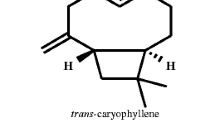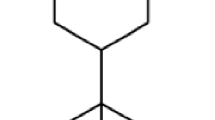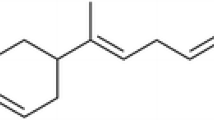Abstract
Essential oils (EOs) from plants may be alternative sources of molecules toxic against mosquito vectors of public health relevance. Most of researches in this field focused on EOs as larvicides or ovicides, while limited efforts focused on the exploitation of EOs as oviposition deterrents. In the present study, the larvicidal and oviposition deterrent activity of Syzygium lanceolatum leaf EO was evaluated against six mosquito species, Anopheles stephensi, An. subpictus, Aedes aegypti, Ae. albopictus, Culex quinquefasciatus, and Cx. tritaeniorhynchus. The chemical composition of the S. lanceolatum EO was analyzed by GC-MS analysis, showing the presence of phenyl propanal, β-caryophyllene, α-humulene, and caryophyllene oxide as major constituents. S. lanceolatum EO showed high acute toxicity on An. stephensi (LC50 = 51.20 μg/ml), Ae. aegypti (LC50 = 55.11 μg/ml), Cx. quinquefasciatus (LC50 = 60.01 μg/ml), An. subpictus (LC50 = 61.34 μg/ml), Ae. albopictus (LC50 = 66.71 μg/ml), and Cx. tritaeniorhynchus (LC50 = 72.24 μg/ml) larvae. Furthermore, the EO was effective as oviposition deterrent against the six tested mosquito species, with OAI on An. stephensi, An. subpictus, Ae. aegypti, Ae. albopictus, Cx. quinquefasciatus, and Cx. tritaeniorhynchus reaching −0.83, −0.81, −0.84, −0.83, −0.84, and −0.86, respectively. The toxicity of S. lanceolatum EO against several biological control agents of mosquitoes, including water bugs (Anisops bouvieri and Diplonychus indicus) and fishes (Gambusia affinis and Poecilia reticulata), was extremely low, with LC50 ranging between 4148 and 15,762 μg/ml. Overall, our results pointed out the promising potential of the S. lanceolatum leaf EO as a source of environmental-friendly oviposition deterrents and larvicides effective against a wide number of mosquito species of importance for parasitology.

Similar content being viewed by others
References
Adams RP (2007) Identification of essential oil components by gas chromatography/mass spectroscopy, 4th edn. Allured Publishing Corporation, Carol Stream
Ahmed F, Chandra JNNS, Timmaiah NV (2009) An in vitro study on the inhibitory activities of Eugenia jambolana seeds against carbohydrate hydrolyzing enzymes. J Young Pharm 1(4):327–331
Autran ES, Neves IA, Silva CSB, Santos GKN, Câmara CAG, Navarro DMAF (2009) Chemical composition, oviposition deterrent and larvicidal activity against Aedes aegypti of essential oils from Piper marginatum Jacq. (Piperaceae). Bioresour Technol 100:2284–2288
Ayyanar M, Subash-Babu P (2012) Syzygium cumini (L.) Skeels: a review of its phytochemical constituents and traditional uses. Asian Pac J Trop Biomed 2(3):240–246
Benelli G (2015a) Research in mosquito control: current challenges for a brighter future. Parasitol Res 114:2801–2805
Benelli G (2015b) Plant-borne ovicides in the fight against mosquito vectors of medical and veterinary importance: a systematic review. Parasitol Res 114:3201–3212
Benelli G (2015c) The best time to have sex: mating behavior and effect of daylight time on male sexual competitiveness in the Asian tiger mosquito, Aedes albopictus (Diptera: Culicidae). Parasitol Res 114:887–894
Benelli G (2016a) Spread of Zika virus: the key role of mosquito vector control. Asian Pac J Trop Biomed 6:468–471
Benelli G (2016b) Plant-mediated biosynthesis of nanoparticles as an emerging tool against mosquitoes of medical and veterinary importance: a review. Parasitol Res 115:23–34
Benelli G (2016c) Green synthesized nanoparticles in the fight against mosquito-borne diseases and cancer – a brief review. Enzym Microb Technol. doi:10.1016/j.enzmictec.2016.08.022
Benelli G, Govindarajan M (2016) Green-synthesized mosquito oviposition attractants and ovicides: towards a nanoparticle-based "lure and kill" approach? J Clust Sci. doi:10.1007/s10876-016-1088-6
Benelli G, Mehlhorn H (2016) Declining malaria, rising dengue and Zika virus: insights for mosquito vector control. Parasitol Res 115:1747–1754
Benelli G, Flamini G, Canale A, Molffeta I, Cioni PL, Conti B (2012) Repellence of Hyptis suaveolens whole essential oil and, major constituents against adults of the granary weevil Sitophilus granarius. Bull Insect 65:177–183
Benelli G, Murugan K, Panneerselvam C, Madhiyazhagan P, Conti B, Nicoletti M (2015) Old ingredients for a new recipe? Neem cake, a low-cost botanical by-product in the fight against mosquito-borne diseases. Parasitol Res 114:391–397
Benelli G, Lo Iacono A, Canale A, Mehlhorn H (2016a) Mosquito vectors and the spread of cancer: an overlooked connection? Parasitol Res 115:2131–2137
Benelli G, Pavela R, Canale A, Mehlhorn H (2016b) Tick repellents and acaricides of botanical origin: a green roadmap to control tick-borne diseases? Parasitol Res 115:2545–2560
Bezerra-Silva PC et al (2016) Evaluation of the activity of the essential oil from an ornamental flower against Aedes aegypti: electrophysiology, molecular dynamics and behavioral assays. PLoS One 11:e0150008
Bhuiyan NI, Begum J, Nandi NC, Akter F (2010) Constituents of the essential oil from leaves and buds of clove (Syzigium caryophyllatum (L.) Alston). African J Plant Sci 4(11):451–454
Boulos L (1983) Medicinal plants of North Africa. Reference publications, Algonac
Chaubey MK (2012) Responses of Tribolium castaneum (Coleoptera: Tenebrionidae) and Sitophilus oryzae (Coleoptera: Curculionidae) against essential oils and pure compounds. Herba Pol 58:33–45
Cheng SS, Liu JY, Tsai KH, Chen WJ, Chang ST (2004) Chemical composition and mosquito larvicidal activity of essential oils from leaves of different Cinnamomum osmophloeum provenances. J Agric Food Chem 52:4395–4400
Cheng SS, Liu JY, Huang CG, Hsui YR, Chen WJ, Chang ST (2009) Insecticidal activities of leaf essential oils from Cinnamomum osmophloeum against three mosquito species. Bioresour Technol 100:457–464
Conti B, Canale A, Bertoli A, Gozzini F, Pistelli L (2010) Essential oil composition and larvicidal activity of six Mediterranean aromatic plants against the mosquito Aedes albopictus (Diptera: Culicidae). Parasitol Res 107:1455–1461
Da Silva RCS, Milet-Pinheiro P, Bezerra da Silva PC, da Silva AG, da Silva MV, Navarro DMAF, Silva NH (2015) (E)-Caryophyllene and α-humulene: Aedes aegypti oviposition deterrents elucidated by gas chromatography-electrophysiological assay of Commiphora leptophloeos leaf oil. PLoS One 9:1–14
Deo PG, Hasan SB, Majumdar SK (1988) Toxicity and suitability of some insecticides for household use. Int Pest Control 30:118–129
Elango G, Rahuman AA, Kamaraj C, Zahir AA, Bagavan A (2010) Studies on effects of indigenous plant extracts on filarial vector Culex tritaeniorhynchus Giles. Parasitol Res 107:167–176
Finney DJ (1971) Probit analysis. Cambridge University Press, London, pp. 68–72
Gamble JS, Fischer CEC (1923) Flora of the presidency of madras, vol I–III. Adlard and Son, London, pp. 1915–1935
Govindarajan M, Benelli G (2016a) Eco-friendly larvicides from Indian plants: effectiveness of lavandulyl acetate and bicyclogermacrene on malaria, dengue and Japanese encephalitis mosquito vectors. Ecotox Environ Saf 133:395–402
Govindarajan M, Benelli G (2016b) α-humulene and β-elemene from Syzygium zeylanicum (Myrtaceae) essential oil: highly effective and eco-friendly larvicides against Anopheles subpictus, Aedes albopictus and Culex tritaeniorhynchus (Diptera: Culicidae). Parasitol Res 115:2771–2778
Govindarajan M, Benelli G (2016c) Artemisia absinthium-borne compounds as novel larvicides: effectiveness against six mosquito vectors and acute toxicity on non-target aquatic organisms. Parasitol Res. doi:10.1007/s00436-016-5257-1
Govindarajan M, Rajeswary M, Benelli G (2016a) Chemical composition, toxicity and effects on non-target organisms of Pinus kesiya essential oil: an eco-friendly larvicide against mosquito vectors. Ecotox Environ Safe 129:85–90
Govindarajan M, Rajeswary M, Hoti SL, Bhattacharyya A, Benelli G (2016b) Eugenol, α-pinene and β-caryophyllene from Plectranthus barbatus essential oil as eco-friendly larvicides against malaria, dengue and Japanese encephalitis mosquito vectors. Parasitol Res 115:807–815
Govindarajan M, Rajeswary M, Benelli G (2016c) δ-Cadinene, Calarene and δ-4-Carene from Kadsura heteroclita essential oil as novel larvicides against malaria, dengue and filariasis mosquitoes. Comb Chem High Throughput Screen 19(7):565–571
Govindarajan M, Rajeswary M, Arivoli S, Samuel T, Benelli G (2016d) Larvicidal and repellent potential of Zingiber nimmonii (J. Graham) Dalzell (Zingiberaceae) essential oil: an eco-friendly tool against malaria, dengue and lymphatic filariasis mosquito vectors? Parasitol Res 115(5):1807–1816
Govindarajan M, Shine K, Naiyf S, Alharbi NS, Benelli G (2016e) Acute toxicity and repellent activity of the Origanum scabrum Boiss. & Heldr. (Lamiaceae) essential oil against four mosquito vectors of public health importance and its biosafety on non-target aquatic organisms. Environ Sci Pollut Res. doi:10.1007/s11356-016-7568-2
Gurib-Fakim A (2006) Medicinal plants: traditions of yesterday and drugs of tomorrow. Mol Asp Med 27:1–93
Hemingway J, Ranson H (2000) Insecticide resistance in insect vectors of human disease. Annu Rev Entomol 45:371–391
Isman MB (2008) Botanical insecticides: for richer, for poorer. Pest Manag Sci 64:8–11
Khandagle AJ, Tare VS, Raut KD, Morey RA (2011) Bioactivity of essential oils of Zingiber officinalis and Achyranthes aspera against mosquitoes. Parasitol Res 109:339–343
Kim H, Chen F, Wu C, Wang X, Chung H, Jin Z (2004) Evaluation of antioxidant activity of Australian tea tree (Melaleuca alternifolia) oil and its components. J Agric Food Chem 52:2849–2854
Komalamisra Y, Trongtokit Y, Rongsriyam Y, Apiwathnasorn C (2005) Screening for larvicidal activity in some Thai plants against four mosquito vector species. Southeast Asian J Trop Med 36(6):1412–1422
Kramer WL, Mulla MS (1979) Oviposition attractants and repellents of mosquitoes: oviposition responses of Culex mosquitoes to organic infusions. Environ Entomol 8:1111–1114
Lee S, Najiah M, Wendy W, Nadirah M (2009) Chemical composition and antimicrobial activity of the essential oil of Syzygium aromaticum flower bud (clove) against fish systemic bacteria isolated from aquaculture sites. Front Agric China 3(3):332–336
Mabberly DJ (1997) The plant book. A portable dictionary of the vascular plants, 2nd edn. Cambridge University Press, Cambridge
Mahmoud II, Marzouk MS, Moharram FA, El-Gindi MR, Hassan AM (2001) Acylated flavonal glycoside from Eugenia jambolana leaves. Phytochemistry 58(8):1239–1244
Maisuthisakul P, Suttajit M, Pongsawatmanit R (2007) Assessment of phenolic content and free radical-scavenging capacity of some Thai indigenous plants. Food Chem 100:1409–1418
Mehlhorn H (ed) (2015) Encyclopedia of parasitology, 4th edn. Springer, New York 893
Mendonca FAC, Silva KFS, Santos KK, Ribeiro JKAL, Sant'Ana AEG (2005) Activities of some Brazilian plants against larvae of the mosquito Aedes aegypti. Fitoterapia 76:629–636
Naqqash MN, Gökçe A, Bakhsh A, Salim M (2016) Insecticide resistance and its molecular basis in urban insect pests. Parasitol Res 115:1363–1373
Nascimento JC et al (2013) Larvicidal activities and chemical composition of essential oils from Piper klotzschianum (Kunth) C. DC. (Piperaceae). Pest Manag Sci 69:1267–1271
Nassar MI, Gaara AH, El-Ghorab AH, Farrag A-RH, Hui Shen H, Huq E, Mabry TJ (2007) Chemical constituents of clove (Syzygium aromaticum, fam. Myrtaceae) and their antioxidant activity. Rev Latinoam Quim 35(3):47–57
Noudogbessi JP, Yedomonhan P, Sohounhloue DCK, Chalchat JC, Figueredo G (2008) Chemical composition of essential oil of Syzygium guineense (Willd.) DC. Var. Guineense (Myrtaceae) from Benin. Rec Nat Prod 2(2):33–38
Pavela R (2015) Essential oils for the development of eco-friendly mosquito larvicides: a review. Ind Crop Prod 76:174–187
Pavela R, Benelli G (2016a) Ethnobotanical knowledge on botanical repellents employed in the African region against mosquito vectors - a review. Exp Parasitol 167:103–108
Pavela R, Benelli G (2016b) Essential oils as eco-friendly biopesticides? Challenges and constraints. Tr Plant Sci. doi:10.1016/j.tplants.2016.10.005
Pavela R, Canale A, Mehlhorn H, Benelli G (2016) Application of ethnobotanical repellents and acaricides in prevention, control and management of livestock ticks: a review. Res Vet Sci 109:1–9
Prajapati V, Tripathi AK, Aggarwal KK, Khanuja SPS (2005) Insecticidal, repellent and oviposition-deterrent activity of selected essential oil against Anopheles stephensis, Aedes aegypti and Culex quinquefasciatus. Bioresour Technol 96:1749–1757
Rajaganesh R, Murugan K, Panneerselvam C, Jayashanthini S, Aziz AT, Roni M, Suresh U, Trivedi S, Rehman H, Higuchi A, Nicoletti M, Benelli G (2016) Fern-synthesized silver nanocrystals: towards a new class of mosquito oviposition deterrents? Res Vet Sci 109:40–51
Raina VK, Srivastava SK, Aggarwal KK, Syamasundar KV, Kumar S (2001) Essential oil composition of Syzygium aromaticum leaf from little Andaman India. Flavour Frag J 16(5):334–336
Ravi Kiran S, Bhavani K, Sita Devi P, Rajeswara Rao BR, Janardhan Reddy K (2006) Composition and larvicidal activity of leaves and stem essential oils of Chloroxylon swietenia DC against Aedes aegypti and Anopheles stephensi. Bioresour Technol 97(18):2481–2484
Reynertson KA, Basile MJ, Kennelly EJ (2005) Antioxidant potential of seven myrtaceous fruits. Ethnobot Res Appl 3:25–35
Silva MF et al (2016) Composition and biological activities of the essential oil of Piper corcovadensis (Miq.) C. DC (Piperaceae). Exp Parasitol 165:64–70
Santos GKN, Dutra KA, Barros RA, Câmara CAG, Lira DD, Gusmão NB, Navarro DM (2012) Essential oils from Alpinia purpurata (Zingiberaceae): chemical composition, oviposition deterrence, larvicidal and antibacterial activity. Ind Crop Prod 40:254–260
Sivagnaname N, Kalyanasundaram M (2004) Laboratory evaluation of methanolic extract of Atlantia monophylla (family: Rutaceae) against immature stages of mosquitoes and non-target organisms. Mem Inst Oswaldo Cruz 99:115–118
Stalin N, Swamy PS (2013) Leaf essential oil composition and biochemical activity of an endangered medicinal tree Syzygium caryophyllatum (L.) Alston, (wild black plum). J Essent Oil Bear Pl 17(3):371–379
Stasi LCD, Hiruma-Lima CA (2002) Plantas Medicinais na Amazonia e na Mata Atlantica, 2nd edn. Editora Unesp, Sao Paulo
Wong KC, Lai FY (1996) Volatile constituents from the fruits of four Syzygium species. Flavour Frag J 11(1):61–66
World Health Organization (2005) Guidelines for laboratory and field testing of mosquito larvicides. Communicable disease control, prevention and eradication, WHO pesticide evaluation scheme. WHO, Geneva, WHO/CDS/WHOPES/GCDPP/1.3
Xue RD, Barnard DR, Ali A (2001) Laboratory and field evaluation of insect repellents as oviposition deterrents against the mosquito Aedes albopictus. Med Vet Entomol 15:126–131
Acknowledgements
The authors are grateful to the Professor and Head of the Department of Zoology, Annamalai University for the laboratory provisions granted.
Author information
Authors and Affiliations
Corresponding authors
Ethics declarations
All applicable international and national guidelines for the care and use of animals were followed. All procedures performed in studies involving animals were in accordance with the ethical standards of the institution or practice at which the studies were conducted.
Funding
G. Benelli is sponsored by PROAPI (PRAF 2015) and University of Pisa, Department of Agriculture, Food and Environment (Grant ID: COFIN2015_22). Funders had no role in the study design, data collection and analyses, decision to publish, or preparation of the manuscript.
Conflict of interest
The authors declare that they have no conflicts of interest.
Additional information
Responsible editor: Philippe Garrigues
Rights and permissions
About this article
Cite this article
Benelli, G., Rajeswary, M. & Govindarajan, M. Towards green oviposition deterrents? Effectiveness of Syzygium lanceolatum (Myrtaceae) essential oil against six mosquito vectors and impact on four aquatic biological control agents. Environ Sci Pollut Res 25, 10218–10227 (2018). https://doi.org/10.1007/s11356-016-8146-3
Received:
Accepted:
Published:
Issue Date:
DOI: https://doi.org/10.1007/s11356-016-8146-3




